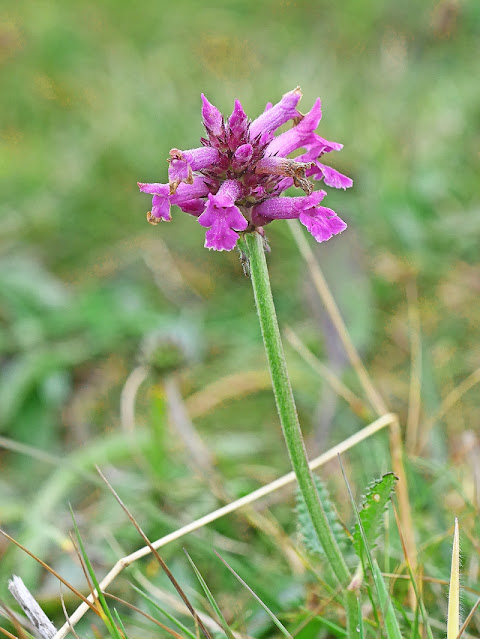A wet August was followed by a wetter September, but I managed to get out and about between the rain bands. Here are the plants I found of interest this month in Cornwall.
A trip to Lerryn produced several clumps of Marsh Mallow. This is a very unusual plant for Cornwall and was believed introduced some years ago or escaped from a nearby garden perhaps. Regardless, it has spread naturally around 500m from where it was first seen, so it is likely to persist here and spread further along the estuary.
Althaea officinalis
Further along Lerryn Creek was a small tidal offshoot with a few saltmarsh plants growing in it, including this hybrid between Long-stalked and Babington's Orache. It takes a bit of practice to work these out, but the stems being foliose to the tips; the bracteoles having tubercles and only open at the top and some of the bracteoles having stalks to 1cm long help define it. Oraches aren't glamorous plants, so many people can't identify them properly.
Atriplex x taschereauii
Woodland along the estuary had several copses of the invasive Himalayan Honeysuckle, an attractive and often planted garden plant, but one that spreads in damp woodland rapidly in Cornwall.
Leycesteria formosa
In the nearby woodland I found a single clump of Common Cow-wheat, now not so common overall!
Melampyrum pratense subsp pratense
Bitter Vetch still with some flowers on a rural road verge.
Lathyrus linifolius
Now that the roadworks have finished on the A30 around Carland Cross, it makes it easier for me to travel West, so I took a trip to Pendeen Cliff in SW Cornwall. Betony was flowering on the clifftop turf.
Betonica officinalis
Ona clifftop road grew Himalayan Balsam, another invasive species. Amongst the many familiar pink flowered plants were a few with all white flowers.
Impatiens glandulifera
Upright Hedge Parsley on a clifftop road verge.
Torilis japonica
An English Stonecrop with a late, solitary flower.
Sedum anglicum
Back to the other end of the county and a trip to Kit Hill, hoping to find some late flowering Field Gentians. Unfortunately I found no trace of them and it is possible they have died out there. However I did stumble across a single spike of Autumn Ladies Tresses in the same area. This species was completely new to Kit Hill, so a great, albeit accidental find. It was verified a few days later by the local conservationists and will now have its habitat looked after accordingly.
Spiranthes spiralis
Fairy Flax was also abundant here.
Linum catharticum
A sunny afternoon meant that I took the opportunity to go on a local trip to Harbour Cove which is a system of sand dunes in the Camel Estuary. I last visited here in June a couple of years back on a Cornwall Botany Group trip and saw some amazing plants. I didn't expect to find much this late in the year, but what follows is what I did find of interest.
Sharp Rush is large with stiffly pointed leaves that can cause a bad cut, Harbour Cove is a stronghold for it here.
Juncus acutus
A Marsh Woundwort gave some colours to the damper areas.
Stachys palustris
The most unusual find of that day was a clump of Orange-peel Clematis growing in the dunes along with its native cousin Traveller's Joy. It was a new species for me too. It had been recorded here some years before, but it's an uncommon garden escape.
Clematis tangutica
Sea Spurge grew in abundance on the dunes too.
Euphorbia paralias
Come the end of September I visited Carnsew Pool in Hayle, hoping to find Perennial Glasswort. It was first recorded here some 12 years or so ago and a small clump was reported. As such, I expected to search through masses of Common Glasswort (the most common Glasswort in Cornwall) to try and find Perennial Glasswort hiding within it. I need not have worried. No longer was there a small clump, there were thousands of plants in a line at the top of the saltmarsh stretching for about 100m.
Sarcocornia perennis
Long-stalked Glasswort was previously only recorded from Copperhouse Pool to the East of Hayle. It was now in Carnsew Pool to the west in good numbers too.
Salicornia dolichostachya
A photo of the west end of Carnsew Pool at Hayle. The darker vegetation in the mud is Perennial Glasswort and it goes off into the bend in the distance.
Red Goosefoot was in large patches along the shoreline of Carnsew Pool, they start off green but are now turning deep red, from where they get their name.
Oxybasis rubra
Viper's Bugloss with a solitary flower still open.
Echium vulgare
Wild Teasel, a real bee magnet when in flower, and when in seed, food for finches over the Winter.
Dipsacus fullonum
Finally, some Common Centaury, with nicely open flowers in the early Autumn sunshine.
Centaurium erythraea
I hope you enjoyed the plants I selected for September, as I write it's early October and still raining most days, but there are still plenty of plants and flowers to find. Until next time, take care.
Dave



































No comments:
Post a Comment
All comments are moderated before publication, so please don't bother spamming me, thank you. Genuine comments most welcome.